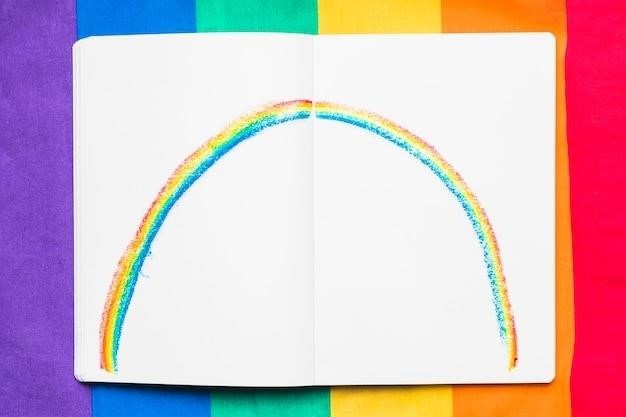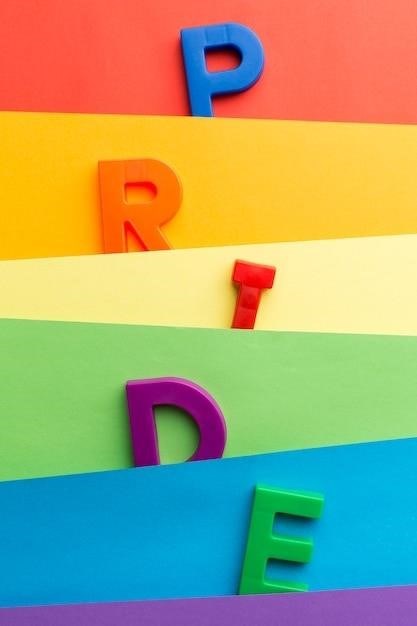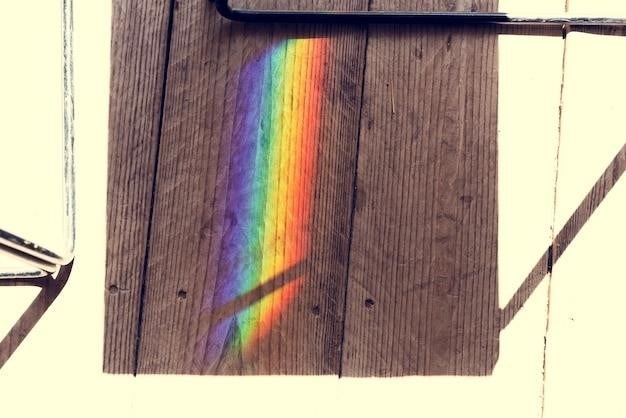The Biblical Significance of Rainbows
The rainbow, a breathtaking spectacle of color, holds profound biblical significance. In Genesis, it symbolizes God’s covenant with Noah, a promise never again to destroy the earth by flood. This enduring symbol represents God’s faithfulness and mercy, offering hope and reassurance to humanity.
The Rainbow Covenant in Genesis
The pivotal moment establishing the rainbow’s biblical significance occurs in Genesis 9⁚8-17. Following the Great Flood, God establishes a covenant with Noah, promising never again to destroy all life on Earth with a flood. This divine promise is visually represented by the rainbow, a celestial arc of vibrant hues appearing in the sky after the rain. God declares the rainbow as a sign of this covenant, a perpetual reminder of His faithfulness and mercy. The rainbow’s appearance serves as a comforting symbol for humanity, offering assurance amidst the uncertainties of life. This covenant, sealed with a visual promise, underscores God’s commitment to preserving creation and His enduring relationship with humanity. The rainbow, therefore, transcends its natural beauty, becoming a powerful testament to God’s grace and unwavering commitment. This covenant stands as a cornerstone in understanding the profound symbolic weight of the rainbow within biblical context.

Symbolic Meanings of Rainbow Colors
While the Bible doesn’t explicitly detail the symbolic meaning of each individual rainbow color, the rich symbolism associated with colors throughout scripture allows for interpretation. Many believe each color within the rainbow’s spectrum carries its own spiritual weight, reflecting various aspects of God’s character and His interaction with humanity. Red, often associated with sacrifice and passion, might represent Christ’s atoning sacrifice. Orange, symbolizing joy and creativity, could reflect the vibrant expression of faith. Yellow’s association with intellect and wisdom might point to divine guidance. Green, representing growth and renewal, could signify spiritual growth and restoration. Blue, often linked to divine protection and truth, might symbolize God’s unwavering faithfulness. Indigo and violet, representing spirituality and mystery, could allude to the divine’s unknowable aspects. These interpretations are not definitive, but rather offer potential avenues for deeper spiritual reflection on the rainbow’s multifaceted symbolism.
Red⁚ Passion and Sacrifice
In biblical contexts, the color red frequently symbolizes sacrifice and passionate devotion. The blood of sacrificial lambs, a crucial element in Old Testament rituals, vividly represents atonement and God’s covenant with His people. This connection between red and sacrifice extends to the New Testament, where Christ’s blood, shed on the cross, is depicted as the ultimate sacrifice for humanity’s redemption. The deep crimson hue, therefore, carries immense weight, representing not only the physical pain and suffering endured but also the immense love and selfless act of atonement. Red’s intensity also represents the burning passion of God’s love for his creation, a fierce and unwavering commitment to salvation. Interpreting red within the rainbow’s context, it could symbolize the passionate sacrifice of Christ, the unwavering love driving His act of redemption, a vital cornerstone of Christian faith.

Orange⁚ Creativity and Joy
While not explicitly detailed in biblical texts, orange, a blend of red’s passion and yellow’s intellect, symbolically represents creativity and joy within a broader spiritual context. Orange evokes a sense of warmth, vibrancy, and enthusiasm, mirroring the exuberant expressions of faith and worship found throughout scripture. The color’s association with the harvest season suggests abundance and God’s provision, reflecting the joy and gratitude experienced by believers. Furthermore, orange can symbolize the creative power of God, evident in the diverse and beautiful world He created. Consider the artistry of nature, from the intricate patterns of flowers to the majestic expanse of the heavens; these aspects of creation can be linked to the vibrant energy of orange. Thus, within the rainbow, orange serves as a reminder of the boundless creativity and joy inherent in God’s plan, a testament to His abundant blessings and the vibrant life He offers to those who follow Him.
Yellow⁚ Intellect and Wisdom
In biblical symbolism, yellow, a radiant and luminous color, often represents intellect and wisdom. Its association with the sun, a source of light and life, connects it to divine illumination and understanding. Yellow signifies enlightenment, the ability to discern truth from falsehood, and the pursuit of knowledge. Think of the wisdom of Solomon, renowned for his discerning judgment, a quality often linked to the clarity and brightness of yellow. The color’s association with gold, a precious metal often used in sacred objects and settings, further reinforces its connection to divine value and spiritual richness. Moreover, yellow can symbolize the illuminating power of God’s word, guiding believers toward truth and understanding. It represents the mental acuity needed to interpret scripture, grapple with complex theological concepts, and apply biblical principles to daily life. Therefore, within the spectrum of the rainbow, yellow serves as a potent reminder of the importance of intellectual and spiritual growth, urging believers to seek wisdom and understanding in their pursuit of faith.
Green⁚ Growth and Renewal
Green, a vibrant hue symbolizing life, growth, and renewal, holds a significant place in biblical interpretations of the rainbow’s colors. Its association with nature’s flourishing – lush vegetation, fertile lands, and abundant harvests – connects it to God’s provision and the promise of new beginnings. Green signifies the restoration of life after devastation, mirroring the post-flood world where vegetation thrived once more. It speaks of spiritual growth, the blossoming of faith, and the continuous process of transformation and development in a believer’s life. Just as a seed germinates and grows into a mature plant, so too does faith develop and mature over time, nurtured by God’s grace and spiritual nourishment. Furthermore, green can symbolize hope and the enduring power of life amidst challenges; It reminds us of God’s restorative power, his ability to bring life out of death and to create beauty from destruction. This color within the rainbow serves as a potent symbol of the transformative power of faith, suggesting continuous spiritual growth and the ongoing renewal of life in Christ.
Blue⁚ Divine Protection and Truth
In the biblical context of the rainbow’s symbolism, blue resonates deeply with divine protection and unwavering truth. Often associated with the vast expanse of the heavens and the limitless nature of God’s power, blue evokes a sense of security and reliance on a higher power. The color’s connection to water, a life-giving element, reinforces this theme of divine provision and sustenance. Moreover, blue’s association with truth and faithfulness mirrors God’s unwavering commitment to his promises. Just as the clear blue sky often signifies a serene and stable environment, so too does God’s faithfulness provide a steadfast foundation for believers. The unwavering truth of God’s word, represented by the steadfast blue, offers solace and guidance in times of uncertainty. The color’s calming effect further enhances its symbolic representation of peace and tranquility, reflecting the secure and protected life promised to those who trust in God’s unwavering truth and protective embrace. This steadfastness inspires faith and confidence in God’s promises, providing a sense of comfort and safety under His divine protection.
Indigo and Violet⁚ Spirituality and Mystery
Indigo and violet, the deepest hues in the rainbow, carry a profound spiritual significance within the biblical context. Indigo, often associated with intuition and inner wisdom, represents the deeper spiritual understanding that comes from a connection with the divine. It symbolizes the mysteries of faith, the insights gained through prayer and contemplation, and the journey towards spiritual enlightenment. Violet, a regal color often linked to royalty and authority, further emphasizes the sacred and transcendent nature of God. Its rarity in nature mirrors the unique and profound experience of spiritual connection. The combination of indigo and violet in the rainbow’s spectrum suggests a journey from the intuitive understanding represented by indigo to the ultimate authority and majesty embodied by violet. Together, they represent the awe-inspiring and mysterious aspects of the divine, a realm beyond human comprehension but accessible through faith and spiritual seeking. These colors invite contemplation on the mysteries of God’s plan and the depth of spiritual growth available to those who seek Him.
The Rainbow’s Enduring Relevance
The rainbow’s symbolism, deeply rooted in biblical narrative, maintains its potency in contemporary life. Its enduring message of God’s covenant, a promise of hope and protection, resonates across generations. The vibrant spectrum, a testament to God’s creative power, continues to inspire awe and wonder. In a world often marked by uncertainty and strife, the rainbow serves as a powerful reminder of God’s unwavering faithfulness and mercy. Its presence, whether in the sky after a storm or depicted in art and literature, offers comfort and reassurance. The rainbow’s timeless message transcends cultural boundaries, speaking to the human longing for hope, peace, and a divine connection. It symbolizes the beauty and promise inherent in the divine plan, offering a beacon of light amidst life’s challenges and a tangible symbol of God’s enduring covenant with humanity. This enduring relevance ensures the rainbow remains a potent symbol of faith and hope.
